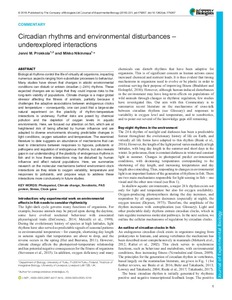Circadian rhythms and environmental disturbances–underexplored interactions
Mikko Nikinmaa; Jenni M. Prokkola
https://urn.fi/URN:NBN:fi-fe2021042719657
Tiivistelmä
Biological rhythms control the life of virtually all organisms, impacting numerous aspects ranging from subcellular processes to behaviour. Many studies have shown that changes in abiotic environmental conditions can disturb or entrain circadian (∼24 h) rhythms. These expected changes are so large that they could impose risks to the long-term viability of populations. Climate change is a major global stressor affecting the fitness of animals, partially because it challenges the adaptive associations between endogenous clocks and temperature – consequently, one can posit that a large-scale natural experiment on the plasticity of rhythm–temperature interactions is underway. Further risks are posed by chemical pollution and the depletion of oxygen levels in aquatic environments. Here, we focused our attention on fish, which are at heightened risk of being affected by human influence and are adapted to diverse environments showing predictable changes in light conditions, oxygen saturation and temperature. The examined literature to date suggests an abundance of mechanisms that can lead to interactions between responses to hypoxia, pollutants or pathogens and regulation of endogenous rhythms, but also reveals gaps in our understanding of the plasticity of endogenous rhythms in fish and in how these interactions may be disturbed by human influence and affect natural populations. Here, we summarize research on the molecular mechanisms behind environment–clock interactions as they relate to oxygen variability, temperature and responses to pollutants, and propose ways to address these interactions more conclusively in future studies.
Kokoelmat
- Rinnakkaistallenteet [19207]
